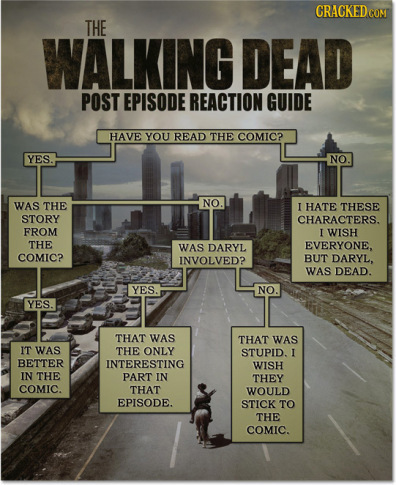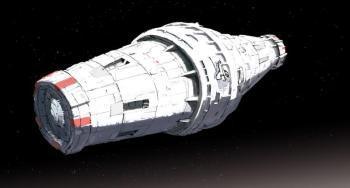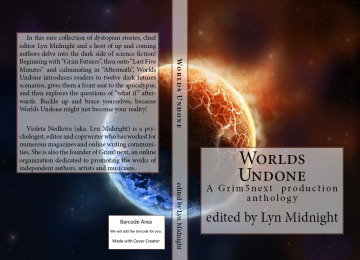Matthew S. Williams's Blog, page 198
July 10, 2012
Of Faster-Than-Light Travel
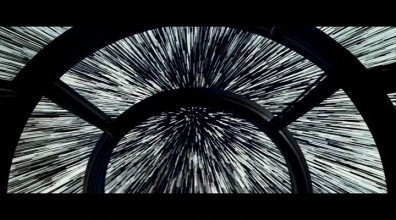 It’s a popular concept, the fictional technology that could help us break that tricky light barrier. And it’s not hard to see why. The universe is a really, really, REALLY big place! And if we ever want to begin exploring and colonizing our tiny corner of it – and not have to deal with all the relativistic effects of time dilation and long, long waits – we better find a way to move faster.
It’s a popular concept, the fictional technology that could help us break that tricky light barrier. And it’s not hard to see why. The universe is a really, really, REALLY big place! And if we ever want to begin exploring and colonizing our tiny corner of it – and not have to deal with all the relativistic effects of time dilation and long, long waits – we better find a way to move faster.
And this is where various franchises come up with their more creative take on physics and the natural universe. Others, they just present it as a given and avoid any difficult, farfetched, or clumsy explanations. And in the end, we the viewers go along because we know that without it, space travel is going to be one long, tedious, and mind-bendingly complex journey!
Alcubierre Drive: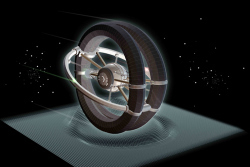 Proposed by Miguel Alcubierre as a way of resolving Einstein’s field equations, the Alcubierre Drive is an untested by possible way to achieve FTL travel. As opposed to Warp, Foldspace, or most other proposed means of FTL that involve some kind of internal propulsion of jump drive, the Alcubierre Drive is based on the idea of generating a wave that a ship would then “surf” in order to travel.
Proposed by Miguel Alcubierre as a way of resolving Einstein’s field equations, the Alcubierre Drive is an untested by possible way to achieve FTL travel. As opposed to Warp, Foldspace, or most other proposed means of FTL that involve some kind of internal propulsion of jump drive, the Alcubierre Drive is based on the idea of generating a wave that a ship would then “surf” in order to travel.
The creation of this wave would cause the fabric of space ahead of the spacecraft to contract and the space behind it to expand. The ship would then ride this wave inside a region of flat space known as a warp bubble and be carried along as the region itself moves through space. As a result, conventional relativistic effects such as time dilation would not apply in the same way as if the ship itself were moving.
The Alcubierre drive is featured in a few different science fiction genres, mainly those of the “hard” variety. This includes Stephen Baxter’s Ark, M. John Harrison’s novel Light, Warren Ellis and Colleen Doran’s Orbiter, and Ian Douglas’s Star Carrier where it is the primary means of transport.
FTL Drive: The primary means of interstellar travel in the Battlestar Galactica universe, where every ship larger than a in-system transport is equipped with an FTL drive. How it works is never really explained, but it is clear that the technology is complex and involves a great deal of calculation. This is not only to ensureolve n accurate relocation through space-time, but also to make sure they don’t up jumping too close to a planet, star, or worse, right in the middle of either.
The primary means of interstellar travel in the Battlestar Galactica universe, where every ship larger than a in-system transport is equipped with an FTL drive. How it works is never really explained, but it is clear that the technology is complex and involves a great deal of calculation. This is not only to ensureolve n accurate relocation through space-time, but also to make sure they don’t up jumping too close to a planet, star, or worse, right in the middle of either.
Whereas Colonial ships use their own computers to calculate jumps, Cylon ships rely on the Hybrid. These “machines” are essentially semi-organic computers, and represent the first step in Cylon evolution from pure machines to organic beings. Apparently, the hybrids were more sophisticated than Colonial computers, especially the aging Galactica. Hence, they were able to calculate jumps more quickly and accurately.
Holtzman Drive: This FTL drive system comes to us from the Dune universe, and is otherwise known as a “Foldspace Engine”. Relying on principles that are not entirely clear to those in the Dune universe, the system involves depositing a ship from one point in space-time to another instantaneously. Though the workings of the drive are never really explained, it is intimated in Chapterhouse: Dune that tachyons are involved.
This FTL drive system comes to us from the Dune universe, and is otherwise known as a “Foldspace Engine”. Relying on principles that are not entirely clear to those in the Dune universe, the system involves depositing a ship from one point in space-time to another instantaneously. Though the workings of the drive are never really explained, it is intimated in Chapterhouse: Dune that tachyons are involved.
Another key component in the system is a Guild Navigator, a mutant who has been given natural prescient abilities thanks to constant exposure to spice. Using this prescience, the Navigator “sees” a path through space-time in order to guide the ship safely through. But in time, the Ixians invented a machine that was capable of doing this job as well, thus making the entire process automated and breaking the Guild’s monopoly on spacing.
Hyperspace: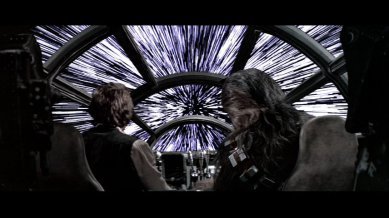 Like the Warp drive, the terms hyperspace and hyperdrive have become staples withing the science fiction community. It’s most popular usage comes from Star Wars where it is the principle means of interstellar travel. Though it is never explained how a hyperdrive works, it is made abundantly clear through a series of visuals in the first and subsequent movies that it involves speeds in excess of the speed of light.
Like the Warp drive, the terms hyperspace and hyperdrive have become staples withing the science fiction community. It’s most popular usage comes from Star Wars where it is the principle means of interstellar travel. Though it is never explained how a hyperdrive works, it is made abundantly clear through a series of visuals in the first and subsequent movies that it involves speeds in excess of the speed of light.
In addition, Han Solo indicated in the original movie that the Falcon’s top speed was “point five past light-speed”, indicating that it can travel 1.5 c. All other references to hyperspace speed factors in the franchise are similar, with velocities given in terms of a decimal point value. As a fast ship, the Falcon can reach point five, whereas most of the larger Imperial and Rebel ships can make only point three or four at most.
Though Star Wars is the most popular example of hyperspace, it is by no means the earliest. The first recorded example was in John Campbell’s “Islands of Space,” which appeared in Amazing Stories in 1931. Arthur C. Clarke’s also mentioned hyperspace in his 1950 story Technical Error. However, the most enduring example comes from Asimov’s Foundation universe, where hyperspace is the principal means of travel in the Galactic Republic. In I, Robot, the invention of the “hyperspatial drive” is the basis of one of the short stories, and was meant to provide a sense of continuity with his earlier Foundation series.
Other franchises that feature the concept of hyperspace include Babylon 5, Homeworld, Macross/Robotech, and Stargate. Combined with Star Wars and the Foundation series, it is the most popular – albeit the most ill-defined -form of FTL in the realm of science fiction.
Infinite Probability Drive: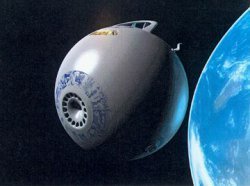 The perfect mixture of irreverence and science: the Infinite Probability Drive from The Hitchhikers Guide to the Galaxy. This FTL concept is based on a particular perception of quantum theory which states that a subatomic particle is most likely to be in a particular place, such as near the nucleus of an atom, but there is also a small probability of it being found very far from its point of origin.
The perfect mixture of irreverence and science: the Infinite Probability Drive from The Hitchhikers Guide to the Galaxy. This FTL concept is based on a particular perception of quantum theory which states that a subatomic particle is most likely to be in a particular place, such as near the nucleus of an atom, but there is also a small probability of it being found very far from its point of origin.
Thus, a body could travel from place to place without passing through the intervening space if you had sufficient control of probability. According to the Guide, in this way the drive “passes through every conceivable point in every conceivable universe almost simultaneously,” meaning the traveller is “never sure where they’ll end up or even what species they’ll be when they get there” and therefore it’s important to dress accordingly!
Subspace Jump Drive: Here we have an FTL concept which comes from one of my favorite games of all time, Descent Freespace. Subspace jumps, relying on the drive system of the same name, represent a very quick method of interstellar travel. By relying on subspace “corridors” that run from one point in space-time to another, a ship is able to move quickly from one star system to the next.
Here we have an FTL concept which comes from one of my favorite games of all time, Descent Freespace. Subspace jumps, relying on the drive system of the same name, represent a very quick method of interstellar travel. By relying on subspace “corridors” that run from one point in space-time to another, a ship is able to move quickly from one star system to the next.
The only drawback to this concept is the fact that travel must occur along officially designated “nodes”. These nodes usually pass between large gravitational sources (i.e. between stars systems) but also can exist within a system itself. Virtually all nodes are unstable, existing for mere seconds or minutes at a time. However, nodes which will last for centuries or longer are designated as “stable” and used for transit.
Another favorite franchise which uses a similar concept is the Wing Commander universe. In all versions of the game, particularly Wing Commander: Privateer, interstellar travel comes down to plotting jumps from predesignated points in space. One cannot simply jump from one spot to another provided accurate calculations are made, they have to use the mapped out points or no jump is possible. This, as opposed to hyperspace travel, posits that subspace is a reality that exists only in certain areas of space-time and must be explored before it can be used.
TARDIS: Officially, the Time and Relative Dimension in Space is a time machine and spacecraft that comes to us from British science fiction television program Doctor Who and its associated spin-offs. Produced by the advanced race known as the Time Lords, an extraterrestrial civilization to which the Doctor belongs, this device that makes his adventures possible.
Officially, the Time and Relative Dimension in Space is a time machine and spacecraft that comes to us from British science fiction television program Doctor Who and its associated spin-offs. Produced by the advanced race known as the Time Lords, an extraterrestrial civilization to which the Doctor belongs, this device that makes his adventures possible.
Basically, a TARDIS gives its pilot the ability to travel to any point in time and any place in the universe. Based on a form of biotechnology which is grown, not assembled, they draw their power primarily from an artificial singularity (i.e. a black hole) known as the “Eye of Harmony”. Other sources of fuel include mercury, specialized crystals and a form of temporal energy.
Each TARDIS is primed with the biological imprint of a Time Lord so that only they can use it. Should anyone else try to commandeer one, it undergoes molecular disintegration and is lots. The interior of a TARDIS is much larger than its exterior, which can blend in with its surroundings using the ship’s “chameleon circuit”. Hence why it appears to outsiders as a phone booth in the series.
Warp Drive: Possibly the best known form of FTL travel which comes to us from the original Star Trek and its many spinoffs. In addition to being a prime example of fictional FTL travel, it is also perhaps the best explained example.Though said explanation has evolved over time, with contributions being made in the original series, TNG, and the Star Trek technical manual, the basic concept remains the same.
Possibly the best known form of FTL travel which comes to us from the original Star Trek and its many spinoffs. In addition to being a prime example of fictional FTL travel, it is also perhaps the best explained example.Though said explanation has evolved over time, with contributions being made in the original series, TNG, and the Star Trek technical manual, the basic concept remains the same.
By using a matter/antimatter reactor to create plasma, and by sending this plasma through warp coils, a ship is able to create a warp bubble that will move the craft into subspace and hence exceed the speed of light. Later explanations would go on to add that an anti-matter/matter reaction which powers the two separate nacelles of the ship are what create the displacement field (the aforementioned “bubble”) that allows for warp.
Apparently, Warp 10 is the threshold for warp speed, meaning that it is the point at which a ship reaches infinite speed. Though several mentions are made of ships exceeding this threshold, this was later explained as being the result of different scales. Officially, it is part of the Star Trek canon that no ship is capable of exceeding Warp 10 without outside help. When that occurs, extreme time dilation, such as anti-time, occurs, which can be disastrous for the crew!
In addition to Star Trek, several other franchises have made mention of the Warp Drive. This includes StarCraft, Mass Effect, Starship Troopers, and Doctor Who.
Final Thoughts:
Having looked through all these examples, several things become clear. In fact, it puts me in mind of a clip produced by the Space Network many years ago. Essentially, Space explored the differences between FTL in past and present franchises, connecting them to developments in real science. Whereas Warp and Hyperspace tended to be the earliest examples, based on the idea of simply exceeding the speed of light, thereby breaking the law of physics, later ideas focused on the idea of circumventing them. This required that writers come up with fictional ideas that either relied on astrophysics and quantum theory or exploited the holes within them.
One such way was to use the idea of “wormholes” in space-time, a hypothetical theory that suggests that space is permeated by topological holes that could act as “shortcuts” through space-time. A similar theory is that of subspace, a fictional universe where the normal rules of physics do not apply. Finally, and also in the same vein, is the concept of a controlled singularity, an artificial black hole that can open a rift through space-time and allow a ship to pass from one point in the universe to another.
Explanations as to how these systems would work remains entirely hypothetical and based on shaky science. As always, the purpose here is to allow for interstellar travel and communications that doesn’t take decades or even centuries. Whether or not the physics of it all works is besides the point. Which brings me to two tentative conclusions.
Explanations Need Not Apply: Given the implausible (or at the very least, inexplicable) nature of most FTL concepts, the best sci-fi is likely to be the stuff that doesn’t seek to explain how its FTL system of choice works. I’st simply there and does the job. People hit a button, push a lever, do some calculations, or fly into a jump gate. Then boom! seconds later (or days and weeks) and they find themselves on the other side, light years away and ready to do their mission!
That’s Hard: Given how any story that involves relativistic space travel, where both time dilation and confusing time jumps are necessarily incorporated into the story, only the hardest of hard sci-fi can ever expect to do without warp drives, hyperspace, jump or FTL drives. Any other kind of sci-fi that is looking to be accessible, and therefore commercially successful, will have to involve some kind of FTL or face extinction.
Well, that’s all I got for the time being. In the meantime, keep your eyes on the skies and don’t stop dreaming about how we’re one day going to get out there. For even if we start sending ships beyond our solar system in the near future, it’s going to be well into the distant future before they get anywhere and we start hearing back from them. At least until someone figures out how to get around Einstein’s Theory of Relativity, damn bloody genius! Until then, I’d like to sign off with a tagline:
This has been Matt Williams with another conceptual post. Good night, and happy spacing!








July 9, 2012
Top 15 Things You’ll Never Hear a Geek Say
 This really doesn’t happen, but it seems I gave myself an idea with that last post. And to think it all came of an inappropriate joke! Essentially, I began to joke about the kinds of things geeks never say and even listed a few. And it got me thinking, one thing this blog has been missing up until now is a top ten list of things you’ll never hear a geek say. Well, I tried to limit myself to ten, but it was impossible. And so I expanded it a little to incorporate just a few more. I know, top 15 lists aren’t as impressive, but what can you do? Sometimes, you just gotta be inclusive!
This really doesn’t happen, but it seems I gave myself an idea with that last post. And to think it all came of an inappropriate joke! Essentially, I began to joke about the kinds of things geeks never say and even listed a few. And it got me thinking, one thing this blog has been missing up until now is a top ten list of things you’ll never hear a geek say. Well, I tried to limit myself to ten, but it was impossible. And so I expanded it a little to incorporate just a few more. I know, top 15 lists aren’t as impressive, but what can you do? Sometimes, you just gotta be inclusive!
Oh, and word of warning, if you’re not a fan of inappropriate jokes, back yourselves up now because you don’t want to see some of the things I’ve written here. As a self-professed geek, I can say these things, but rest assured, my test audience (my wife) didn’t exactly react well  You’ve been warned! Anyhoo, here they are, the top 15 things geeks never say, in ascending order:
You’ve been warned! Anyhoo, here they are, the top 15 things geeks never say, in ascending order:
15. “Jane Austin is a far superior writer to Ursula K. Le Guin”
14. “I would have liked to have seen less cleavage and more character development from 7 of 9″ (substitute any female lead from Star Trek)
13. “The blue chick from Avatar was so not hot”
12. “George R.R. Martin didn’t hit his stride until the third book”
11. “There’s no way I’m paying 50 bucks for a video game!”
10. “I can see no difference between Captain Kirk and Picard”
9. “Blade Runner totally needs to be remade”
8. “I have no strong opinions either way on the remake”
7. “They made a show called The Big Bang Theory?”
6. “I didn’t see the new Star Trek movie, but I hear it’s good.”
5. “Frank Herbert would be so proud of what’s become of the Dune franchise”
4. “You’ll never catch me jerking off to anime!”
3. “The prequels are just as good as the original”
2. “The movie was just as good as the book”
1. “George Lucas didn’t rape my childhood!”
And I’m still thinking of some doozies! Oh well, maybe this can become a thing, but only top 10 lists from now on. 15 at a time is not a pace I foresee being able to keep up for long. Until next time, geek out, get your geek on, and keep on geeking in the free world! Have I found enough ways to work that into a cliched saying?








The Walking Dead Viewing Guide
Found this over at Cracked.com, where some smart-ass nerd who obviously knows the comic backwards and forwards thought he’d mock the show. Having never read the comic, I can’t comment on the rightness of this little guide, but let’s just say I intend to now. Being a fan of the show, much like most people I’ve talked to here on the subject, saying that they are vastly inferior to the comics makes me think that I’m missing something.
But of course its called comedy for a reason. And as I’m sure we are all aware, every franchise geek since the beginning of time has had the same thing to say vis a vis adaptations. In fact, if you were to make a top 10 list of things franchise geeks never say, number one would be “The movie was just as good as the book”… right after, “the prequel was just as good as the original” and “George Lucas didn’t rape my childhood” 








The Future is Here: The Google Neural Net!
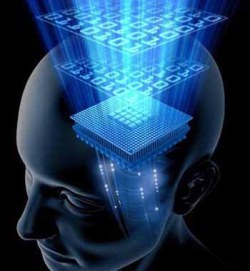 I came across a recent story at BBC News, one which makes me both hopeful and fearful. It seems that a team of researchers, working for Google, have completed work on an artificial neural net that is capable of recognizing pictures of cats. Designed and built to mimic the human brain, this may very well be the first instance where a computer was capable of exercising the faculty of autonomous reasoning – the very thing that we humans are so proud (and jealous) of!
I came across a recent story at BBC News, one which makes me both hopeful and fearful. It seems that a team of researchers, working for Google, have completed work on an artificial neural net that is capable of recognizing pictures of cats. Designed and built to mimic the human brain, this may very well be the first instance where a computer was capable of exercising the faculty of autonomous reasoning – the very thing that we humans are so proud (and jealous) of!
The revolutionary new system was a collaborative effort between Google’s X Labs division and Professor Andrew Ng of the AI Lab at Standford University, California. As opposed to image recognition software, which tells computers to look for specific features in a target picture before being presented with it, the Google machine knew nothing about the images in advance. Instead, it relied on its 16,000 processing cores to run software that simulated the workings of a biological neural network with about one billion connections.
Now, according to various estimates, the human cerebral cortex contains at least 1010 neurons linked by 1014 synaptic connections – or in lay terms, 10 trillions neurons with roughly 1 quadrillion connections. That means this artificial brain has one one thousandth the complexity of the organic, human one. Not quite as complex, but it’s a start… A BIG start really!
For decades – hell, even centuries and millennia – human beings have contemplated what it would take to make an autonomous automaton. Even with all the growth in computer’s processing speed and storage, the question of how to make the leap between a smart machine and a truly “intelligent” one has remained a tricky one. Judging from all the speculation and representations in fiction, everyone seemed to surmise that some sort of artificial neural net would be involved, something that could mimic the process of forming connections, encoding experiences into a physical (i.e. digital) form, and expanding based on ongoing learning.
Naturally, Google has plans for an application using this new system. Apparently, the company is hoping that it will help them with its indexing systems and with language translation. Giving the new guy the boring jobs, huh? I wonder what’s going to happen when the newer, smarter models start coming out? Yeah, I can foresee new generations emerging over time, much as new generations of iPods with larger and larger storage capacities have been coming out every year for the past decade. Or, like faster and faster CPU’s from the past three decades. Yes, this could very well represent the next great technological race, as foreseen by such men as Eliezer Yudkowsky, Nick Bostrom, and Ray Kurzweil.
In short, Futurists will rejoice, Alarmists will be afraid, and science fiction writers will exploit it for all its worth! Until next time, keep your eyes peeled for any red-eyed robots. That seems to be the first warning sign of impending robocalypse!








The O’Neill Cylinder
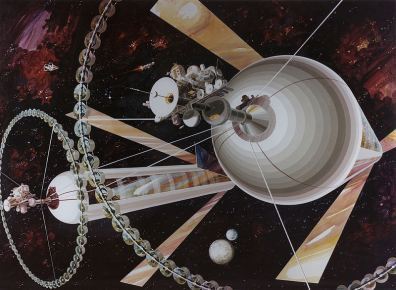 Welcome all to another post that explores the world of conceptual sci-fi! In keeping with the trend of explaining concepts which helped inspire my group’s most recent project, the space colonization story Yuva, I’ve decided to talk about what is known as an O’Neill Cylinder.
Welcome all to another post that explores the world of conceptual sci-fi! In keeping with the trend of explaining concepts which helped inspire my group’s most recent project, the space colonization story Yuva, I’ve decided to talk about what is known as an O’Neill Cylinder.
Named in honor of Gerard K. O’Neill in his 1976 book The High Frontier: Human Colonies in Space, the concept deals with the idea of placing a large cylinder in space that would rotate to provide gravity. Habitats within the cylinder would be built along the walls to ensure uniform gravity.
Some of the more interesting features of this design, aside from the curious layout, is the fact that in such a setting, windows placed in the hull can provide natural illumination, thus cutting down on the electricity bill. If the cylinder is particularly large, in which case one side is invisible to the other, then the rotation can provide periodic light, simulating day and night. And being a single volume of space, it can be pressurized, the gravity increasing pressure near the surface.
Fans of Rendezvous with Rama will recognize this concept right off the bat. The alien vessel in the story, dubbed Rama, was one big O’Neill Cylinder that floated through space, with a city built directly into the interior. A circular lake was also placed at the midway point, known as the Cylindrical Sea. At the far ends of the ship, an entrance and a gravitational drive were placed.
Another example is to be found in the Gibson novel Neuromancer, where a space station known as “Freeside” became the focal point in part III of the story. According to Gibson’s own descriptions, the station was a large cylinder in space owned by the Tessier-Ashpool clan. Their own villa was located at the very tip, a place known as “Straylight”, with luxury apartments, hotels, and vacation spots lining the interior. Artificial illumination was provided by a long band that ran down the middle and obscured a clear view of the other side.
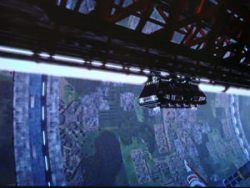 And last, and my personal favorite, is the eponymously named space station of Babylon 5. Built along the same lines as Rama and Freeside, this space station was one giant rotating cylinder which housed over a quarter million humans and aliens. The interior surface was divided between several sectors, each one coded by color.
And last, and my personal favorite, is the eponymously named space station of Babylon 5. Built along the same lines as Rama and Freeside, this space station was one giant rotating cylinder which housed over a quarter million humans and aliens. The interior surface was divided between several sectors, each one coded by color.
 Brown Sector was designated for trade facilities, Blue Sector for personnel facilities, Green for diplomats, Gray for manufacturing, Red for resident habitation, and Yellow for environmental control. Transport along the length of the station was handled by a long rail that was frequented by a transport shuttle. At this point in the station, the gravity was virtually nil and atmospheric pressure was also substantially less.
Brown Sector was designated for trade facilities, Blue Sector for personnel facilities, Green for diplomats, Gray for manufacturing, Red for resident habitation, and Yellow for environmental control. Transport along the length of the station was handled by a long rail that was frequented by a transport shuttle. At this point in the station, the gravity was virtually nil and atmospheric pressure was also substantially less.
All of this was consistent with an O’Neill Cylinder and applied to far more than just the station itself. Just about all Earth ships and installations in the B5 universe contained rotating sections to provide gravity since humanity had not yet stumbled onto the secret of artificial gravity.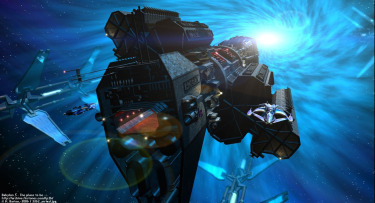
When it comes right down to it, the concept of a rotating space cylinder is a very eloquent idea for simulating gravity, consistent with hard science and realism. Artificial gravity is often used in science fiction as a sort of given, mainly because its convenient and simpler from a design standpoint. Ships that have cylinders and rotation sections are bulky compared to sleek, unrealistic space concepts – space barges compared to flying works of art.
But that’s really not realistic, especially where near-future science fiction is concerned. Like it or not, artificial gravity just isn’t a plausible concept yet, not unless we find that troublesome graviton particle and learn how to harness it in a stable way. Which is why you can tell that a franchise is particularly inspired when you see ships and stations relying on rotation sections to simulate gravity. Not only is it more realistic, its shows that the conceptual artists and writers are doing their homework.
And that’s precisely why the Yuva ships feature them! And I hope people will find that it is indicative of the kind of mindset me and my group have. We like sci-fi, we like realism, and its especially good when hard science and hard fiction come together. Can’t wait until the book is done, all these teasers are driving me nuts!








July 8, 2012
My Personal Writing Tips, or “How to Avoid Rookie Mistakes”
Proofreading and editing can be such a chore, I tell ya! Thought I’ve never been very good at proofreading and criticizing other peoples work, I find that it is when I am called upon to edit and evaluate their work that I most want to retreat into my shell. I feel selfish when this happens, mainly because of all the people I have asked to review my own work and give me their opinions. You’d think I’d be better at this aspect of it!
But of course, I know that part of the reason I hate editing the work of others is because I hate editing my own. I’ve noticed this about most people who enjoy writing, composing, and anything else that requires active revision and corrections. By the time the work is done, they want to put it down and forget about it, to let others handle the business of finding the flaws and pointing out the necessary corrections.
Alas, I’ve had to check most of that baggage ever since I started to become a member of several writing communities. In fact, I’ve even volunteered to act as a contributing editor for two major projects, one of which is the “Yuva Anthology” (begun by Khaalidah and myself), the other being the “Worlds Undone” Anthology. The latter one people might remember from a few months ago, when I was doing mock ups for a cover and happened to find some primo artwork to feature in it. Thanks again to cazzyae at deviantArt for her talent and generosity of spirit for that one! Thanks to her, Createspace’s easy interface, and the suggestions of many people at G5N, here’s how the cover came out:
Unfortunately, that has opened up a different can of worms for me. While I’ve definitely managed to overcome some of my reservations about reading other people’s work, I find that my pet peeves, or what I consider to be the marks of weak writing, keep rearing their ugly head. After reading many stories, I began to think that a tutorial might be in order to help some of the newbies avoid some rookie mistakes, ones which I have committed at least a half dozen times. Each!
I should also take this opportunity to thank Kristen Lamb, who’s impressive article “4 Writing Crutches that Insult the Reader’s Intelligence” reminded me of this idea. After seeing the title in my Inbox, I immediately zoomed over to her site to see if we shared the same pet peeves and sensibilities. Upon reading it, I could tell she was much more versed in this whole writing thing than I am! Still, I happen to share her appraisal of some bad writing habits, especially item number four in her list, “telling instead of showing”.
So, to take a page from her book (no pun!) and to make good on something I’ve been planning to do for some time now, I present you with the list of rookie writing mistakes it is best to avoid. All are the result of what I myself have done repeatedly, and have managed to weed out (for the most part) after many years of practice:
Avoid Infodumping: Never start a story with a long, drawn out passage telling the reader what they need to know in order to set up the plot. For that matter, never let your story digress into such exposition either. A story is by definition a journey, with information, details, twist, and revelations provided bit by bit over time. Even if it’s a short story, never, ever simply announce what’s happening or what the significance of it is. Such actions turn what is supposed to be a tale into a description and is boring to read.
Less is More: When it comes to explanations and descriptions, avoid excessive detailing. You don’t need to tell the reader everything about what’s going on, moment for moment, nor do you need to describe the scene in perfect detail. A simple, straightforward description of the scene and the interactions taking place is enough, let the reader’s imagination fill in the rest. Think of it like telling a crafty lie: if you want someone to believe it, don’t tell them a long story loaded with details, keep it simple, straightforward, and plausible. (Editor’s note: lying is wrong!)
It’s called Background for a reason: One of the best tips I ever got as a writer was to “leave the background in the background.” This kind of overlaps with points one and two, but I keep it separate because of how often I see it and how it has factored into my own work. Much like explaining a scene or dumping info into a chapter, going to great lengths to establish the wider context in which the story takes place (i.e. “universe building”) is a bad idea. Stick to the story, only include that which is absolutely necessary, and let the universe build itself. In time, and if you’re lucky, you’ll get a chance to write follow-up pieces which will allow you to delve into different aspects of your fictitious world in more detail.
“No one talks like this!”: If there’s one thing I learned from the Star Wars prequels and the Dune spinoffs, it’s that wooden dialogue can totally ruin a story. When drafting scenes that call for verbal interaction between characters, always keep in mind that this is supposed to sound like a conversation between actual people. Do not allow yourself to be swayed by duty to the story or the need to establish character elements. Those things that need to be conveyed are best when done with fine strokes and subtlety, and never, ever let your characters fall into expository passages where they simply say what’s goings on. Or to quote the Robot Devil from Futurama: “You’re characters lack subtlety. You can’t have people just announce their feelings! That makes me so angry!”
Referencing: When writing a story that is meant to have allegorical similarities to today, or is meant to make a point about a specific issue, avoid referencing them too closely. Never say, “this was just like that thing that happened back then” or “it’s this all over again”. Let the reader infer what you are referring to with your carefully crafted, fictitious comparison. In Foundation, Asimov never directly compared the Galactic Empire to Rome, nor did Frank Herbert ever mention oil in relation to the spice in Dune. Once again, trust in the reader to make the appropriate conclusions and avoid telling them anything outright. Otherwise, you risk turning an “ah-ha” moment into an unimpressed “oh.”
That’s all I got. Suffice it to say, I am still learning and still looking for ways to perfect my craft. That’s never going to happen, of course, but it’s the goal which provides endless opportunity for improvement. Speaking of which, more samples will be forthcoming soon as I work my way deeper into “Winston Agonistes”, “Crashland”, “Frontera”, and “Fortress”. And most importantly of all, Data Miners will finally be ready for distribution by August long weekend! Yes, after roughly six months of delays, the editing of that story is finally coming to an end. But more on that in a bit.
In the meantime, keep hammering those keys, keep working on those manuscripts, and keep reaching for the brass ring of artistic perfection. And while you’re at it, feel free to share with me some lessons that you’ve learned along the way and feel obliged to share with the newbies in your field. There’s no shortage of lessons, as there are no shortages of mistakes 








“Frontera”
 The following is a sample from a new project that’s been kicking around in My Documents folder for some time now. Many years ago, I was inspired by a books known as Climate Wars by Gwynne Dyer. He confirmed things that were being said about the Mexico-US border, how a sealed, militarized border was in fact being considered in some circles within the Pentagon.
The following is a sample from a new project that’s been kicking around in My Documents folder for some time now. Many years ago, I was inspired by a books known as Climate Wars by Gwynne Dyer. He confirmed things that were being said about the Mexico-US border, how a sealed, militarized border was in fact being considered in some circles within the Pentagon.
And given the relevance of Climate Change and the likelihood that it will make life uncomfortable for millions of people worldwide, not to mention triggering massive waves of emigration and border conflicts, I thought I should tackle the issue in fiction! And after some serious research into the Mexican-American border, the National Guard, and Climate Change, I began to create an outline that I eventually named “Frontera”.
It is my attempt at capturing the kinds of forces and feelings that natural disasters, starvation, and the looming specter of death inspire. On the one hand, you’ve got the drive to survive by any means necessary, to endure endless suffering and indignity. On the other, you’ve got the inevitable reaction of those who want to keep the suffering out of their lives, also by any means necessary. “See no evil, hear no evil,” we all know the drill.
And so, I give you “Frontera”, or what will eventually be the epilogue if it ever expands into a full-length novel: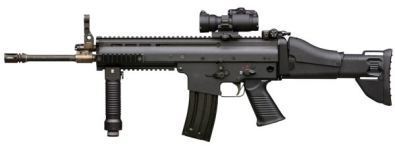
The dust was starting to die down with the passing of the last storm. The heat was picking up on the highway too, turning the asphalt into heat devils and the desert into baked tufts of dirt and sand. Windows are down and the speedometer reads sixty, the radio at ninety eight point five megahertz. Tuned to the classics! The army radio is turned low so they don’t get any distracting chatter from the squad RO.
Corporal Atkins looked at the seat next to him, PFC Fitzgerald sitting there with his boot on the dashboard. He sees the business end of the SCAR sitting on his lap, pushes it ahead with his index finger just a little. The safety being on or not, he doesn’t want to hit a bump and find out the hard way that it could go off.
“So…?”
“So what?” says Fitz.
“What happened next?”
Fitz smiles and puts both feet down on the floor. His hands fly up, providing the story with manual illustrations.
“Well, he comes into the house. And she’s screaming at him to stop acting all crazy and shit. And I’m under the bed, all I can see is his boots. But man, if shoe size be any indication…” he paused for emphasis. “Anyways, this guy was a bear. Real fucking crazy too, from the sound of it. Kept going on and on about how she was cheating on him.”
“She was,” Fitz says. Fitz waves him off and keeps talking.
“Whatever, point is, she’s trying to tell him not to freak out and he’s not even supposed to be there, and he’s stomping around looking this way and that, tossing her clothes out of the closet and everything. Finally, he gives up, which is good for me, because I swear he looked everywhere but under the bed.”
Atkins hums an affirmative and nods.
“So he figures she’s alone, breaks down, starts crying! He’s saying how sorry he is and how much he misses her, how much he wants her back and how it’s going to be different this time. I’m telling ya, it was pathetic!”
“So you got out with all your teeth intact… again?”
Fitz slams his boot up on the dash again. “What can I tell ya, I’m lucky like that? Besides, girl’s need a man who’s around, not some migrant laborer who aint at home half the year.”
Atkins shakes his head. He could make the obvious point of how migrants have it hard as it is. Moving from state to state to work the farmlands, being paid on an irregular basis, no security, no benefits. Bad enough to have to deal with all that, they don’t need the added stress of wondering whether their wives are cheating on them or not. Then again, their lives aren’t so easy either. Whatever a man’s got to do to stay happy and loose, he can’t begrudge him for. Not too much anyway.
“Right here!” Fitz says, slapping him in the shoulder. Fitz looks over and sees the turnoff, nearly past them now. He cranks the wheel around and brings the Humvee into a sharp turn, nearly sending Fitz through the window in the process. Their left front tire skims into the gutter, throwing Fitz the other way now, his helmet grazing Fitz’s shoulder. When he’s got them righted on the dirt road, he guns the gas and sends clouds of dust up in their wake. Taking a moment to steady himself, Fitz gives him a look.
“You alright there, man?”
“Me? Yeah, of course! Ship shape!”
“Okay…” Fitz says skeptically while retrieving his SCAR and putting it butt down on the floor. He eyes Fitz for a moment longer, wondering if he’s just a little too hung over to be driving right now. But then, the sentry post appears over on the horizon and his attention snaps back to their front bumper, to the chain link fence that is slowly emerging out of the dirt. Then to the pockmarked field beyond it, the sloping earth, the tattered debris.
They drive for another five minutes before the road came to parallel the fence and the guard post is just ahead on their left. A hand is raised in the sentry booth, the heavy barreled weapon going limp as the gunner waves to them.
“Who’s on today?” Fitz asks.
“Uh, Perkins, I think,” says Fitz.
Fitz grabs the handset from the radio and brings it to his mouth. He checks briefly to make sure they’re on the squad frequency before keying the button on the side.
“Bravo Two to Sentry one-nine, how’s the weather up there, over?”
Fitz looks up just in time to see Perkins swing by overhead, his hand going to the mike in front of his mouth. He turns from the border momentarily to watch them scream on by.
“Just fine, you bunch of AC pampered assholes, over.”
Fitz laughs out loud and quickly responds.
“Got any housekeeping for us today, over?”
It takes Perkins a couple seconds to reply.
“Just some gutters need cleaning. Tell the maid to get on it, over!”
Fitz hangs up the mike and shakes his head. “Always chipper, the guys who pull morning duty. Especially after pulling an all-nighter!”
“Guess that’s why they don’t have to clean up their own shitty mess.”
“You got that right.”
Fitz pulled them into a tight turn towards the fence and hit the brakes just a few feet from running into it. The engine idled as he let it run, keeping the AC blowing and the radio blasting the tunes. He looked over to Fitz, nodded in the direction of the field.
“Are you shitting me? I gotta do this alone?”
Fitz shrugged. “Driver takes the wheel, shotgun gets the shaft.”
Fitz flashed Atkins a look that told him just how much he hated him. Popping his door and slinging his SCAR over his shoulder, he went to the back and grabbed everything he needed to get the job done. Two industrial strength garbage bags, a trench shovel, some rubber gloves and a sanitary mask. Packing them all into one of the two bags, he set for the fenceline.
Just a few feet from the vehicle was the access door, a single steel frame with chain link innards, the opening side locked by a bolt lock that could only be opened from the Arizona side. Fitz unbolted the thing and slung the door open, pausing only to look back at the sentry tower. Perkins waved at him again before manning his gun again, communicating both thanks and sympathy in that one gesture. Fitz flipped him the bird and ducked on through.
Past the door was the remote sensor: a standing tube-like appendage with a bulbous, LED laden device on top. Fitz was sure to pause as he came close to it, giving it a moment to read the RFID card in his pocket. All Guardsmen had them, as a guarantee against accidentally setting one of the mines off. As he waited for the thing to finish reading him and chime the all clear, he scanned the area that ran the border, the pockmarked field of caked dirt they called No Man’s Land, or as the sentries preferred it, the Kill Zone. Where the dirt had been disturbed, he could see the porcupine quills of freshly planted AP’s breaking the surface. Elsewhere, the dirt was a deep brown or black, usually not far from a fresh mine. Only one spot today contained the splattered remains of a WB that had chanced to cross the field the night before. Perhaps it had been more than one; two buddies, a couple, a small family. After the AP’s got to them, the vultures quickly moved in and took anything that was still fresh. However, the carrion birds often triggered an AP too, confounding the mess and adding to the clean-up crew’s workload.
Clean-up crews like me.
The sensor chimed and the LED’s turned green. Fitz began to pace forward into the field, kicking at the caked dirt as he went. Past several groups of quills with their temporarily dormant sensors, making his way to the pile of flesh, bone, and ripped clothes rotting in the morning sun. Soon, he was close enough to see enough to make out what was left of the brave soul (or souls) that had perished the night before.
As usual, the remains seemed to be scattered out into a circular pattern, but most of that was in pulp form. In terms of solid remains, there were only two large pieces, some minor bits strewn between them that looked to have been picked pretty well by the carrion feeders already. One piece was covered in a length of ripped denim, clearly a jean leg, with the remains of the leg still inside, the femur having been ripped out from the pelvis. A few feet over, the better part of an arm with some of the original ribcage attached lay, though the hand appeared to be missing. From all this, he could surmise that the WB had been alone when he went down. Most likely he was hit by one AP after he tripped its detector, it exploded in midair and knocked him down flat onto another. The dispersal pattern and what remained of him seemed to confirm this.
A single vulture stood over the pieces, tearing what it could off the femur. Grabbing the bag from under his arm, Fitz began to kick at the thing. The vulture squawked and protested at him, but eventually flew clear.
“Greedy little scavengers,” he said, slipping the rubber gloves and breath mask on. Lowering his goggles into place to protect his eyes – one had to be sure diseases weren’t getting in through the tear ducts – he grabbed a hold of the remains and began stuffing them into the bag. The arm proved the most difficult; getting it to bend at the elbow was proving tough once he got it into the bag. Given that there was little meat on it, did it make sense that it would be in some kind of rigor? He tried twice, nearly ripped the bag open, and had to bring it out again.
“What’s going on out there?” he heard Fitz yelling with the window rolled down. Fitz cursed over his shoulder. Finally, he put the elbow joint above his knee and pried it hard. The whole thing cracked like some chicken bones and was finally small enough to dispose of. He tossed it in the bag, threw the other assorted bits in after it, and tied the other bag around the whole thing. Slinging that over his shoulder and repositioning his SCAR, he made his way back to the fence.
Fitz was still sitting with the window rolled down when he got there.
“Seriously, what took you so long?”
“Just drive the fucking vehicle.”
Fitz threw the bag into the driver’s side rear door, into the yellow bin marked Biohazard. Tossing in his gloves and mask too, he jumped back into the cabin without another word. Fitz shrugged and waved one last time to Perkins and brought them back onto the dirt road, gunning the engine for the next post and the next potential mess.








July 7, 2012
So you loved The Hunger Games...what should you read next?
 Reblogged from molly spring writes:
Reblogged from molly spring writes:





If I had a nickel for every time I have been asked to recommend a book that is “like The Hunger Games,” I could double my paycheck. It’s great that kids are excited about reading, but I hate that even though we have multiple copies of the most popular read-alikes, they are often checked out. Our dystopian/post-apocalyptic reading list hadn’t been updated in over a year, so at first I started to add to that, but I realized that it wasn’t capturing everything that attracted readers to…
What more can I say? Just read the freaking article. It's free...
Dystopan Literature Over Time
Came across this list on Goodreads, thanks largely to Molly Spring’s post (which I will reblog next since it’s pretty dawn awesome!). Basically, the table gives graphic representation to historical trends and the popularity of dystopian lit over the past few decades. Though it does preclude Yevengy Zamyatin’s We and Jack London’s The Iron Heel by a few years, it manages to pick up in the early 30′ with the creation of Brave New World.
Cataloging what led to the creation of that and all many subsequent dystopian classics, the creator of this infographic shows how our perceptions and tastes – as expressed through popular dystopian visions – have changed over time. In the end, the point seems to be that we’ve evolved from thinking simply that the state is the primary threat to human freedom in our world. Things like body image, reproductive rights, environmental issues, nuclear weapons, epidemics (both man-made and natural) and agism.
You might think that it’s making the point that people have more to worry about today than they did before. But personally, I just think it’s pointing out how the literature is evolving to focus on our own evolving sense of self and understanding of ourselves. You know the old saying, “the world isn’t any worse, you just understand it better?” Well, it’s a little like that. The literature isn’t any darker, just more complex. Quite the little romp too, if you ask me. 








The Foundation Series
 When it comes to science fiction, few authors have achieved the kind of notoriety and prolific ouput of Isaac Asimov. Amongst the greats of classic sci-fi, he considered one of the “Big Three”, along with arry Niven and Arthur C. Clarke. And when it comes to his many novels, short stories, articles and thoughtful essays, two series stand out above all else. The Robot series and, more importantly, the Foundation novels.
When it comes to science fiction, few authors have achieved the kind of notoriety and prolific ouput of Isaac Asimov. Amongst the greats of classic sci-fi, he considered one of the “Big Three”, along with arry Niven and Arthur C. Clarke. And when it comes to his many novels, short stories, articles and thoughtful essays, two series stand out above all else. The Robot series and, more importantly, the Foundation novels.
Not only did they get the ball rolling on many major sci-fi themes that would come up again and again over the years (such as the concept of a Galactic Empire), they once again brought commercial science fiction into the limelight by showing how hard science could be merged with real history to produce genuinely thought-provoking literature. This is a trend which seems to be necessary once every generation years or so, with Frank Herbert doing it again roughly a decade later. And in his case, much of the inspiration came from Asimov himself.
So in honor of that accomplishment, and to mark the occasion that I finally finished reading the original trilogy, I thought it was high time that I start reviewing the Foundation series, beginning with the book that started it all. So without further ado, here’s Foundation!
Plot Synopsis:
The story opens many thousands of years in the future, where humanity has spread to occupy the entire Galaxy and is governed by the Galactic Empire. For over 12,000 the Empire has stood, and appears to still be stable and powerful. However, a trend of decay has set in and some suspect that it’s only a matter of time before the Empire falls
One such man is Hari Seldon, a scientist who has perfected a form of psychology and mathematics known as psychohistory. Having calculated the exact date and sequence of events which will lead to the collapse of the Empire, he has also created an organization that will be dedicated to ensuring that the dark ages that naturally follow will be as brief as possible – one thousands years instead of the alternate 30,000.
Divided into five parts – each of which was published throughout the 1940′s and together in a single volume in 1951 – the story jumps forward in time from the starting point, 0 F.E. (Foundation Era), to several hundred years in the future. Several protagonists are employed, people who find themselves at the center of events in any given period. Each period involves the emergence of a “Seldon Crisis”, a calamity that was predicted by Seldon’s psychohistory in advance, and the requisite response by the Foundation to resolve it. The first story, which sets up the subsequent stories and crises, is aptly named:
The Psychohistorians: Told from the point of view of Gaal Dornick, a young mathematician who has travelled to the capitol world of Trantor to meet Seldon, the story moves from their introduction to Seldon’s arrest by the Committee of Public Safety. Named after the Revolutionary body that send countless French citizens to their death after the 1789 Revolution, this committee is made up of Imperial aristocrats who are angered by Seldon’s philosophy and want to see him silenced. However, not wanting to martyr him, they instead tell him and his Foundation to pack up and move to Terminus, a world on the edge of the Empire.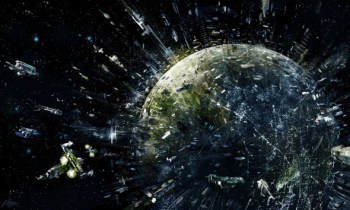
The story then concludes with Seldon telling Dornick that he knew this was coming, and that it was actually all part of the plan. By being able to set up the Foundation at the edge of the Empire, it will be in a perfect position to begin enacting its policies once the Empire begins its inevitable slide into decline and loses control of first the periphery, and then the core systems. Thus, the most important lesson about psychohistory is presented for the first time: like a prescient science, it predicts all things and all things happen in accordance with its laws.
The Encyclopedists: Fifty years later on Terminus, the Foundation scholars have begun work on the Encyclopedia Galactica, the complete compendium of scientific knowledge for when the Empire falls. Unfortunately, the Empire is surrounded by four independent kingdoms that are in danger of threatening Terminus. The mayor of the planet, Salvor Hardin, is the protagonist of this story, and believes that the only way to keep their neighbors at bay is to pit them against each other. He perceives an opportunity when the Kingdom of Anacreon, which hopes to place military bases on Terminus, reveals that the four kingdoms no longer have nuclear technology.
Later, Hardin’s own rivalry with the Board of Trustees (the people responsible for the Encyclopedia) come to a head when Seldon’s Vault – a mysterious chamber which opens whenever a “Seldon Crisis” is imminent – opens to deliver a message. According to Seldon’s hologram, the creation of the Encyclopedia was a ruse to hide Terminus’ real importance. The true goal of the Foundation is to further science in a galaxy as it becomes consumed by interplanetary strife. Realizing that they are no longer in control, the Board hands its political power to the Terminus City mayor who graciously accepts.
The Mayors: Beginning in 80 F.E., this story revolves around the Foundation’s efforts to bring technology to the Four Kindgoms. This has the effect of creating a priesthood of sorts in these states, reminiscent of early medieval Europe where Roman priests were dispatched to western European kingdoms to establish centers of learning. Salvor Hardin has been re-elected many times over the course of the decades but faces an impending problem as an “Action Party” threatens to overthrow him. Fearing that Anacreon is slowly overtaking them, they want power so the Foundation will fight back.
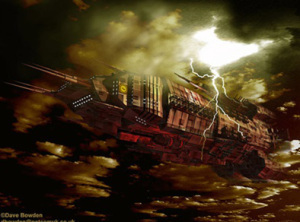 On Anacreon, it is also becoming clear that the young King Lepold I faces an internal threat from his uncle, Prince Regent Wienis. Before he can come of age, Wienis plans on seizing power for himself. Central to this plan is using a battleship the Foundation restored for Anacreon to attack and conquer the planet. On the night that Lepold is to be ordained, Wienis invited Hardin into his quarters and shares his plan with him. Hardin reveals that he too has a plan, a counter stroke which will neutralize the battleship and Wienis’ power.
On Anacreon, it is also becoming clear that the young King Lepold I faces an internal threat from his uncle, Prince Regent Wienis. Before he can come of age, Wienis plans on seizing power for himself. Central to this plan is using a battleship the Foundation restored for Anacreon to attack and conquer the planet. On the night that Lepold is to be ordained, Wienis invited Hardin into his quarters and shares his plan with him. Hardin reveals that he too has a plan, a counter stroke which will neutralize the battleship and Wienis’ power.
After decades of seeing Foundation scientists as “holy men”, the public is incensed when they learn that Wienis is planning an attack on them. What’s more, all their technology, including the attacking battleship, becomes useless as the only people who know how to run them (the Foundation scientists) begin shutting them down. Wienis loses it and tries to kill Hardin, but his weapons cease working, and he takes his own life.
Upon his return to Terminus, Hardin is vindicated when Seldon’s vault opens to reveal that his plan was right. With this crisis behind them, the Action Party defers to the mayors and their authority is once again validated. In addition, the Four Kingdoms are now free to continue the advance of “Scientism”, which will extend their influence throughout the region and ensure the fulfillment of Seldon’s plan.
The Traders: Events in this section take place 135 F.E., at a time when the Foundation has begun sending out Trade representatives to distant worlds to share their technology with all neighboring planets in the quadrant. Master Trader Eskel Gorov, also an agent of the Foundation government, has traveled to the worlds of Askone to trade in nucleics. Gorov, however, is met with resistance by Askone’s governing Elders who abide by the taboo that certain technologies are morally proscribed.
Enter the protagonist, Trader and Foundation agent Linmar Ponyets, who is sent to Askone’s central planet to negotiate the release of Gorov, who has been arrested. After learning that the Elder’s Grand Master plans to have Gorov executed, Ponyets agrees to offer them a payoff in the form of a transmuter than can turn lead into gold. At the same time, Ponyets finds a willing ally in a young protegee named Councilor Pherl. While initially wary of Ponyets, he is convinced that the transmuter could help him to attain power and eventually become Grand Master himself.
Because of this, Gorov is released and travels back to Foundation space with Ponyets. Gorov is critical of Ponyets dealings, saying that it was unethical, but Ponyets counters with a quote by Hardin, wherein he said “Never let your sense of morals prevent you from doing what is right!”
The Merchant Princes: This last story, which takes place in 155 F.E., occurs against the backdrop of a powerful Foundation, which has subjugated the neighboring Four Kingdoms and expanded its commercial and technological empire throughout numerous stellar systems. However, it still faces challenges, this time around from a planet named Korell where three Foundation ships have disappeared. Fearing that a “Seldon Crisis” in coming, the Foundation assigns Master Trader Hober Mallow to investigate and determine the Korellian’s level of technology.
At the same time, the people who assign Mallow, Foreign Secretary Publius Manlio and the Mayor’s secretary, Jorane Sutt, foresee an opportunity to weaken the traders by creating an embarrassing diplomatic incident. To oversee their plan, they plant an agent aboard Mallow’s ship to spy on him. When they arrive on Korell, he invites a Foundation missionary on board their ship, a move which causes a mob to surround the ship. Since Foundation agents and technology are not allowed on Korell, this arouses Mallow’s suspicions.
Mallow hands the missionary over to the mob, in spite of the agents intervention, and the missionary dies. Surprisingly, he doesn’t seem too disturbed by this and even earns the chance to meet with Korell’s authoritarian ruler, Commdor Asper Argo, because of it. He appears friendly and welcomes Foundation technological gifts, though he refuses to allow Scientism on Korell. In accordance, Mallow agrees to continue trading with them but agrees to abstain from encouraging missionary work within the Republic of Korell.
Later, Mallow is also given a tour of the planet’s facilities, during which time he notices the presence of atomic technology bearing the emblem of the Empire. He concludes that the Empire is expanding into the periphery again and journeys alone to the planet Siwenna, which he believes may be the capital of an Imperial province. There he finds nothing but a desolate world and an impoverished patrician named Onum Barr, a former provincial senator who tells him how an a local rebellion led the Empire to devastate the planet and kill all but one of his sons.
Convinced there is nothing there to see, Mallow returns to Terminus where he faces trial for murder because of how he turned the missionary over to the Korellian mob. However, he is able to convince the court that the “missionary” was in fact a Korellian secret policeman who played a part in the conspiracy against the Traders manufactured by Sutt and Manlio. Acquitted, Mallow is received with delight by the population of Terminus, which will almost undoubtedly select him as Mayor in the elections scheduled to take place in the following year.
To prepare for the election, Mallow engineers the arrest of Sutt and Manlio, and eventually takes office. However, he is soon faced with tensions between the Foundation and Korell, which declares war on the Foundation, using its powerful Imperial flotilla to attack Foundation ships. Instead of counterattacking, Mallow takes no action, knowing that Korell has become accustomed to trade with the Foundation and the lack of said trade will cause deprivation and anger towards the government. In time, this will cause Korell’s war efforts to grind to a halt and the end of hostilities.
Thus ends book I of the foundation series, with the Foundation ascendent in a Galaxy that is becoming increasingly permeated by chaos and Seldon’s plan in effect on well underway.
Good Points:
As I said, this novel (if you’ll excuse the pun) really wrote the book on Galactic Empires and historically/socially relevant sci-fi. Inspired largely by Gibbon’s The History of the Decline and Fall of the Roman Empire, it advances the notion that all civilizations are basically organism, subject to the same laws as all living things. And like all organisms, they enjoy a period of growth, maturation, and then decline, culminating in their death. When that happens, their absence leaves a natural power vacuum characterized by chaos, strife, and a marked decline in all things “civilized” – aka. the arts, the sciences, learning, etc.
By taking a page from history, namely the attempts to preserve classical knowledge throughout the Middle Ages (which culminated in a rebirth of learning in the Renaissance) Asimov creates a fictional repeat of history in the distant future whereby the efforts of the preservers were enhanced with the help of foresight and a coordinated plan. Had such factors existed in the wake of Rome’s fall, it is entirely possible that the Dark Ages would have lasted for a significantly shorter amount of time.
On top of that, this book was is also very accessible and readable, in spite of the fact that it throws some rather deep scientific and intellectual content at the reader. And the way the stories are succinct, concise, and tie together so effectively makes for a read which is easy on top of it all. For an accomplished reader, it can be read in one sitting. I am hardly a speed reader, but even I found it a quick study.
Bad Points:
Conversely, some of the books selling points are also potential weaknesses. For one, its accessibility can be seen as a mark of simplicity. For example, the book is all about a science that deals with the masses, of how historical events are determined by the actions of billions, trillions and even quadrillions of people. And yet, in every story, everything seems to hinge on the actions of one person, the protagonist, and a few others.This seems a little contradictory, and intentional since it provides quick resolution to the plot.
Herein lies another weakness, which is that of contrivance. Many times throughout the novel, the way the characters tend to figure things out seems awfully convenient. In every story, you see the mayors, merchants and Foundationists pulling resolutions seemingly out of nowhere, knowing everything they need to in advance or just providing a perfect solution on the spot. Granted, it seems to make sense, but how they know to do this and how it always seems to work out does not seem wholly realistic.
And of course, the explanation is always there in the background, Hari Seldon predicted it using psychohistory and these people know that science so they are therefore prepared where others are not. This sort of advances a notion that the science itself is infallible, that human minds really can be reduced to mathematical formulae which is water-tight. If anything, I would say that predicting the behavior of billions gets more unpredictable the farther afield one looks, and that no science can ever be capable of predicting it with certainty. And we all know what became of those philosophies that tried – aka. Marxism, Hegelianism, and many other isms besides!
But of course, the concept of psychohistory is entirely fictitious and was really just a tentative argument that Asimov advanced, and for the sake of a fictional story no less. In order to make the story work, he had to create a universe in which a form of prescient foresight, made possible through the application of rigorous mathematics and psychology, was possible and accurate. In short, its just food for thought, not something to be taken seriously. And of course, Asimov did show that he was willing to break from this notion with the second book in the series, Foundation and Empire, where the “Plan” began to falter due to external, unaccounted factors.
So in the end, I have to recommend Foundation as required reading, not just for science fiction fans but for all people curious as to how many trends we’ve come to associate with speculative and satirical literature (including dystopian lit) got started. Granted, there were those who came before Asimov who made use of such themes and classical inspirations, but he was the one who brought such things into the public eye like few before him. And as a result, he would go on to have an immeasurable influence on those who followed in his wake.
Up next, Foundation and Empire, part two of the original trilogy, before fans and publishers practically forced him to write many, many more books in the series. Stay tuned!









